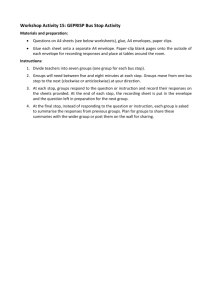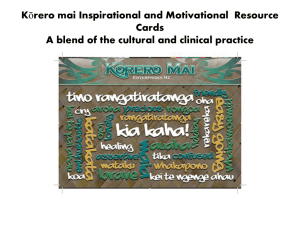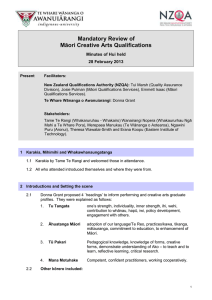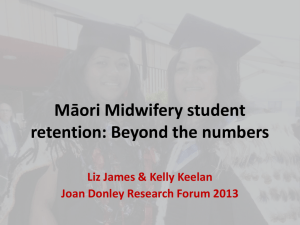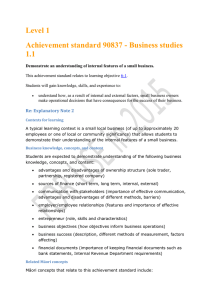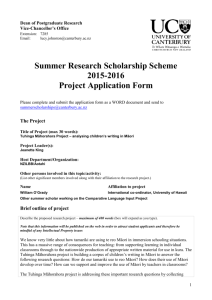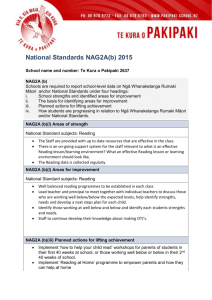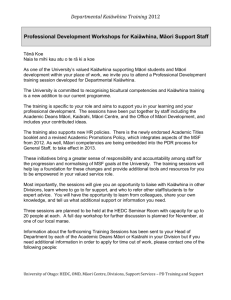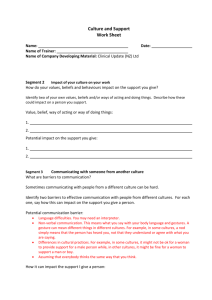Ethic of care jigsaw - pieces - teacher ideas
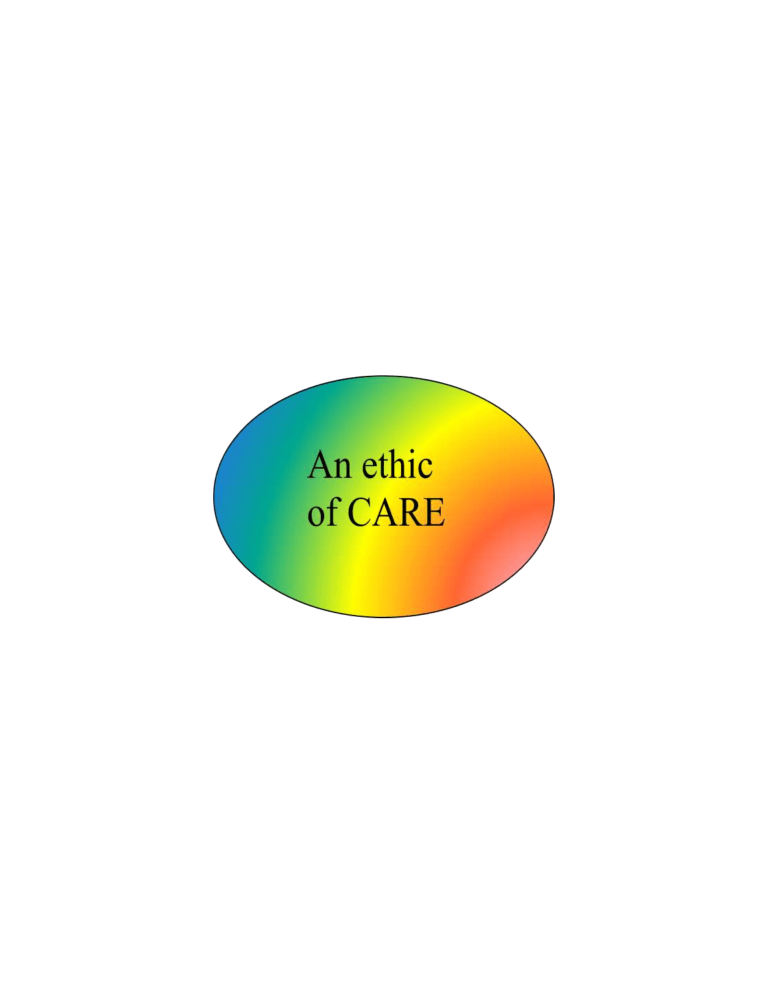
Discussion
Shaping opinions/ viewpoints
Relating events to economic themes/ concepts: o Linking to other curriculum areas (history/ geography) o Relevant economic events
- use of clips (You Tube); newspaper/ video o Individual- to their world
- school; home; city; nation
Economic resources on WALL- student
Teacher shows interest in Māori culture/
ideas art etc o Classroom decoration has both student work plus media reports on ?? local
Economic events
Teacher is knowledgable about
Māori cultural practices,
language tekanga etc and especially local knowledge. o Eg local institutions listed like banks, councils, marae, companies
Uses examples of Māori culture to explain economic ideas o Use examples for media – eg You Tube, work/ posters
Local issues- articles around the room; folders
Politicians- pictures
Student work
Posters - supply/demand graphs,compliments/ substitutes
Interest.co.nz (90 seconds at 9)
Strong economics focus
TV news, blogs, twitter
Encourages Māori students to contribute ideas, own experiences during class and in writtem work o All students to report news/ interesting
items/ topics
Tangata
Whenuatanga
CLASSROOM LOOKS LIKE
Posters on: o Key Terms o Models in economics o Māori concepts around economics o Student created work o Current news related topics being studied
CLASSROOM SOUNDS LIKE
Discussions on economic terms between students and teachers
Using economic terms to explain every day events. eg: o Opportunity costs of....... o Marginal utility of.....
CLASSROOM FEELS LIKE
High expectations
Each student valued and teacher knows about them
Caring environment
Strong relationship between student, their world and economic content
OUTCOMES
Connected learners who take theory and connect to every day
Confident in analysing economic events
Apply economic knowledge to other areas
Exemplars of student work – not just high level
Modelling expectations of behaviour within classrooms (routines are important here) o Eg: come in, books out,
“do now” on board
Be flexible with assessments o Eg: interviews and record a verbal response to an assessment for a student who struggles with written reports
Try to give students the tools to overcome and work within their skill base to express prior knowledge
Learning outcomes visible in room
(eg. On board)
Checklist for students
High yet realistic
expectations
Wānanga
Mana motuhake
Goal setting o Deadlines for presenting
Role modelling/Peer tutoring/Group work
Effective use of data o Knowing the learners needs/ strengths
Tracking progress
Tracking success
Celebrate success
Collaborative goal setting
Modelling their expectations in class/ own notes
Consequences Eg: calling home
Compulsory support
Reward systems
Accentuate the positives o Feedback/feed forward
Self reflection by students o To take ownership of their own learning
Prior knowledge of students academic ability o Data like NCEA results, E asTTle etc
Scaffolding answers/work to move from A to B to C (or A to M to E)
Inspirational sayings
Promoting Māori achievement (in literacy)
Research at the beginning of year on different economies
In a boys school high achieving women/sports people
Enterprising people from different
backgrounds
Different inputs into what happens in NZ
Soloman island posters
Group discussions – different points of view
Rules for discussion – eg right to question immediately
E Learn individual opportunities for Māori students
Environmental
Access to resource room with big tables to sit around for group discussions
Respect and value languages and cultures of
students’
Manaakitanga
Know something/find out something about each student
Pronounce names correctly (or the
way students want)
Sense of humour
Talks to students, ie takes time out to chat and get to know students
Find out about/know something of the cultural beliefs of the student o not judgemental/stereo typing
Be sensitive to and balance “economic” stories
Try to use examples from many cultures not just Pakeha (European NZ)
Correct pronunciation of names o Involve students in planning course / topics of study etc
Make classroom represent ALL of ME – so students can identify with it as their own
Use Māori words etc
Shows respect for cultural expectations and norms o Don’t touch people’s heads, don’t sit on desk, participate in blessings of buildings
Use successful role models in business world to emphasise the positives
From Day 1 – correct pronunciation of names of Māori/Pasifika students
Use of common greetings – drawing on different cultural practices in economic resources used
Inquiry based lessons
- Teacher going around the room rather than up front
- Get in habit of teacher NOT responsible for providing answers
- Ask questions rather than give answers
- why? what?
→supports development of the
important concept?
- All answers valued (avoid other
students ridiculing answers)
- Listen (show interest in answers and questions)
- Waiting- to give time to come up with answer
Allow students to think for themselves
Ako
Understand students’ past and present
experiences and integrate them into learning
experiences to encourage understanding of
higher level concepts
Accept that student perspectives may
include experiences not traditionally discussed in schools
- Different views are not necessarily
right or wrong, they’re just different
- Broad views and opinion in resources
- Help them to develop their own personal
viewpoint NOT JUST promoting parents’ perspective
-Newspaper/ current events articles.
they don’t necessarily bring out students’opinions/ voices but can be discussed
-Blogs/ websites/ chat forums to promote discussion ideas
Give appropriate time for reflection on what students may be being asked + give feedback/ feedforward
Acknowledge limitations + expose them to examples (eg economic models).
Show respect
Give feedback / feedforward advice
Clear instructions- identify purpose of lesson at outset of lesson
Sharing is good
Clear boundaries eg. Behaviour/
starts/ finishes
Clear structure- goals/ AO’s /
SLO’s/ visuals
Wind up
Classroom routines
Nga whakapiringatanga
Set up to allow students to be involved in
“collaborative learning”
Clear learning objectives
Mutual respect, otherwise all routines will fall over quickly
Clear expectations and consistency- point or 5min starter question
Hands up
Confidence to answer
Discussion routine established
Learning outcomes indicated on the board
Quiet entry
End by making sure expectations clear (HW) or clarifying LO’s with respect; with class rules to follow through
Start with news article/ discussion
Try to be in class before students arrive → connect with students as thet arrive (deal with noticed anxiety/ emotional outbursts)
Take roll early
→ correctly pronounce names
Teacher to know the ethnic groups represented by students
Have a laugh
Have a routine / clear boundaries – confort from known routine for:
- discussions; group work; individual student work
Have high expectations- student behaviour; student achievement; student effort Display standard work and change it
No put downs
→sarcasm no place in classroom
KNOW THE LEARNER
Language
Background
etc
TIKANGA
Protocols
Classroom inviting
COOPERATIVE LEARNING
Wiki
Group work
Moodle
Online chat
FEEDBACK IN STUDENT IDEAS
Put in cultural context
Comments not just grade
Shows interest in students’ ideas
Manaakitanga
Plan time to include student ideas/conversations
Listening - use student words
Allow students to ask questions
- not focus on answers
Use student ideas and thinking
(Duff World)
Daily news/cartoons and headlines
discussions
Humour/Topical/Relevant
/Interpretive/Visual/Ironic
Recognition of prior experience/knowledge
Not right or wrong – but different
Open discussion – nurturing/respectful/supportive/environment for collaborative discussion
Positive feedback to student on their work
Display student work
Use student feedback for course planning
“Ako” – student/teacher learn together
Before starting a unit establish what they already know
Find out what they want to know “know the learner”
(Internal) options
student chooses option that matches their interest
Rogues Gallery – left/right wing
Politicians above whiteboard
Sharing of ideas in “SAFETY”
- Showing interest/respect for ideas no matter how unexpected or unorthodox
Thoughtful judgements about economic soundness
Evaluating ideas
Showing students how to get from A to M to E
Use of reflection times
Useful feedback from teachers
INTEREST:
Pedagogy that encourages interest
Technology
Collaborative activities
CONNECTIVITY: to next steps
Realistic (high) expectations o “Always do your best”
Individual progress of learning
Providing exemplars
Incorporating Māori/Pasifika concepts
Inclusive practices o Show interest in student ideas
Giving choices for type of assessment presentation
Contemporary issues o Newspaper articles o B Hickey 90 secs at 9
Modelling best practice
-Uses community as
resoures
- People/parents/
whanau/
Examples they can relate to:
- (lived)Experiences
- Interest
- Community
ASSIGNMENT:
-Link to AO’s/Curriculum
-Feed forward/Feed back
- towards stated Goals and steps to progress
COMMUNITY:
stakeholders
Wānanga
Kotahitanga
Information sheet about students
Pre testing
Pacing lessons
Conferencing with individual students
Pasifika and Te Reo Māori language used in class
Using real life examples
Analysing data – responding appropriately
Peer tutoring
Mentoring groups
Additional support tutorials o University o After school homework group
Provide an environment that includes, supports and encourages all learners
Reward cards
SMART goal setting o self reflection
Variety of teaching and learning strategies o Cooperative learning

